Email marketing has evolved over the years and as the number of internet users worldwide rises, it is set to become the primary form of communicating with customers. In 2020, over 306 billion emails were sent a day, and this is set to increase! With so many emails hitting user’s inboxes, how can you be sure that yours will be opened and read?
Whilst businesses want to harness the power of email marketing, and especially mobile email marketing – 85% of people use smartphones to check emails – many don’t know how to avoid their email going straight to spam or being immediately deleted.
Why emails matter to your business
Emails are one of the most widely used forms of communication and it’s not about to go away. They are an effective form of interacting and collaborating with a variety of people and a cost-effective communication solution that also opens up marketing opportunities.
Email campaigns reach new, future and existing customers every day. Sending a personalized marketing email gives businesses the ability to connect with consumers in a better way, delivering messages that will create a reaction and generate leads.
Why is timing important in email marketing?
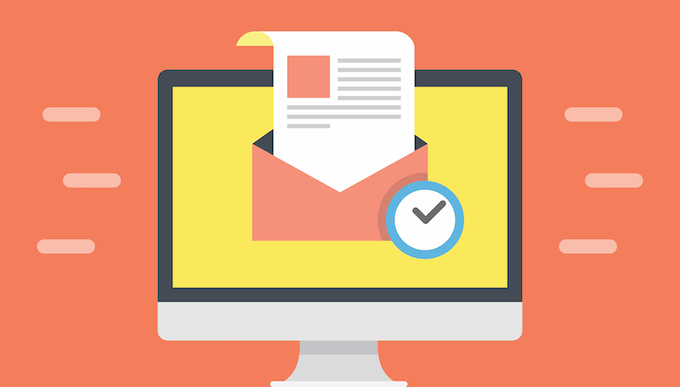
Long gone are the days of printed advertising material. Today, email marketing is the go-to tool for many marketers. But how can you ensure that your email generates the leads you are looking for? One of the main reasons why email marketing fails is down to timing.
Marketers spend so much time focusing on the content that they forget to consider the best time to send emails. The success of an email marketing campaign can be down to timing alone. Which day and what time of day to send an advertising email are crucial considerations if you want to see a better ROI on your campaign.
What does it depend on?
In our modern, digital, mobile world, most people’s work day starts way before they reach the office, or at home desk. Over the past few years, the use of mobile devices to check our emails has risen considerably. Indeed, some people check their emails before they’ve got out of bed!
People check their mobile emails as much as 3x more than their desktops. So, how can marketers capitalize on these open rates? Well, it’s all about reaching the right audience with relevant, personalized content.
- Demographics – today’s email marketing tools are far more adaptable, with an abundance of features to help marketers. Data and subscriber lists can be broken down into different categories, such as:
- Gender
- Age
- Location
- Purchase history
- Preferences
Knowing your audience is one of the most important aspects to get right. Sometimes, the demographics are more crucial than the recommended ‘best times’. For example:
- If you are targeting the tech-savvy, young generation, sending emails in the evening could be the making of your campaign.
- Entertainment industry businesses may benefit from sending emails on a Friday, which is considered a bad day for email campaigns.
A study by GetResponse on sending emails found that the best time for global open rates was 4 am and the best time for CTRs (click through rates) was 6 am.
- Email personalization – according to Conversant Media’s research, 94% of marketing professionals say that personalization is extremely important in meeting their email marketing objectives. Emails that have a personalized subject line is more likely to be opened by as much as 26% (Campaign Monitor).
- Marketing automation – another factor that is impacting the success or failure of email marketing campaigns is marketing automation. Experian’s research showed that transactional emails had 8x more opens and clicks than other emails, and had the potential to generate 6x more revenue. They also found that customers who received automated emails about their abandoned shopping carts were 2.4x more likely to complete their purchase.
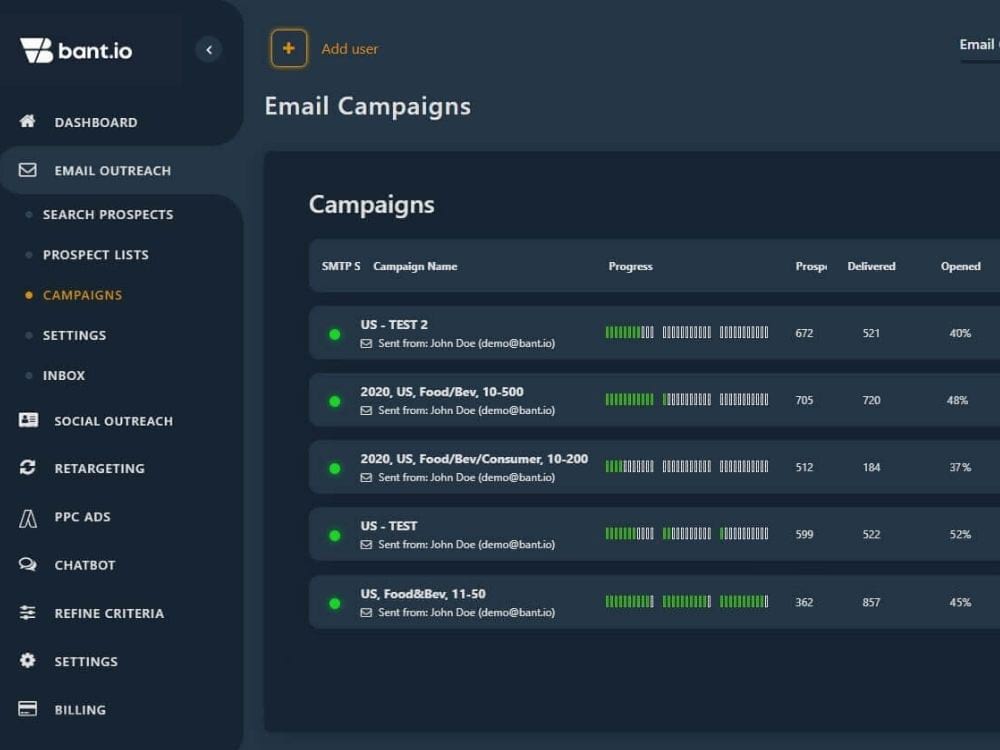
- Message optimization for different devices – with the exponential rise in the use of mobile devices to check emails, any marketer has to ensure their email marketing campaign is adapted for mobile emails. Campaign Monitor found that open rates on mobile devices grew by as much as 68%. As people’s user habits change, so do the timings for sending emails. For example, mobile users are more likely to be active in the evening; not traditionally considered the best time to send an email. It all depends on who you are trying to target with your campaign.
Best days to send emails
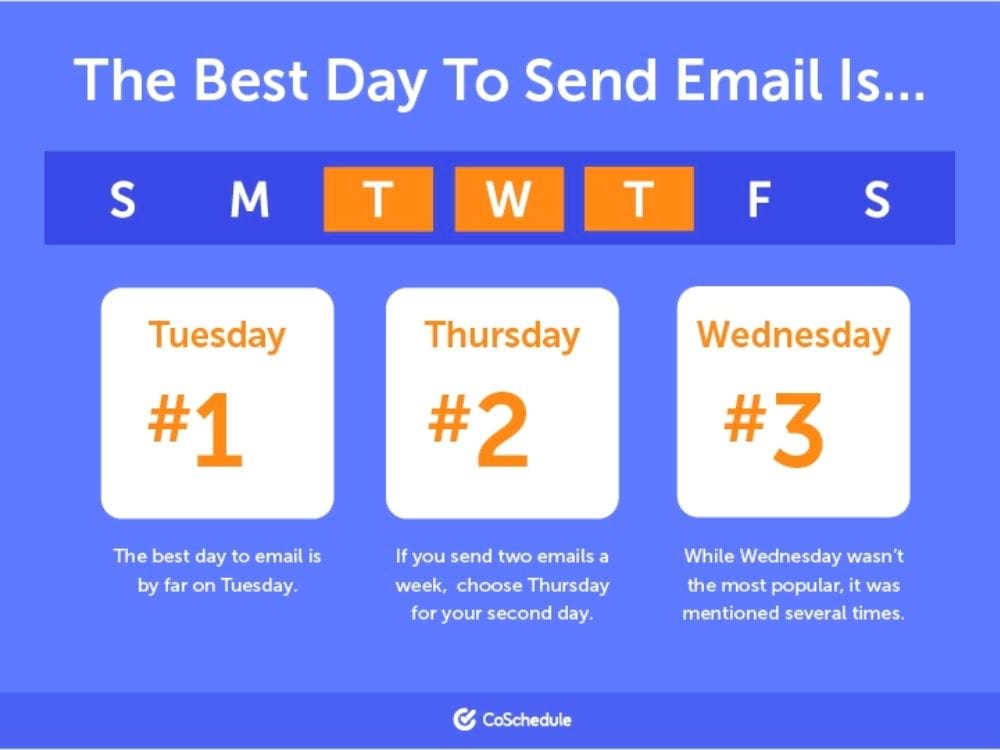
Generally, email marketing industry experts suggest avoiding Mondays and Fridays for sending email campaigns. Tuesdays, Thursdays and Wednesdays – in that order – are considered the best days.
According to studies, Tuesday is the best day overall but if you’re sending out 2 email campaigns in the same week, the second day should be a Thursday. Wednesday was the next favorite. Generally, the middle of the week is considered the optimum time.
But studies are not always right; it depends on your target audience, your industry and the content. For example, sending an email to promote a new service may have a better day than sending a regular newsletter. It’s important that businesses understand their target market and their target audience to select the best day.
Best time of day to send emails

According to data from SuperOffice, late afternoon is the best time to send emails as this has the greatest open rate. But that is a generalization. It really depends on the device, i.e. mobile or desktop. If the email is being opened on a desktop, yes, late afternoon may well be the best time. However, if your target audience’s nature is to open emails via a mobile device, early morning or evening may be a better option.
So, the best time of day to send an email marketing campaign depends on your target audience, your industry and the content; again! But beware of time zones. Sending an email at 10 am on a Tuesday might be suitable for the UK but not for San Francisco in the USA; it’ll be late evening on a Monday there.
Generally, Tuesdays at 10 am is top of the list of the best times of day to send emails. The second spot, surprisingly, goes to Thursday at 8 pm, followed by Wednesday at 2 pm and Tuesday at 6 am.
But experts’ golden advice is to avoid public holidays; that includes the school holiday season and weekends. Even the tech-savvy youngsters won’t be as active on their mobile devices during these periods.
Best time to send B2B emails
Studies suggest that the best time to send B2B email campaigns to office employees is mid-week at around 10 am. This backs-up other research. But, and there’s always a but, if your target audience is C-level executives or business owners, which day of the week is not quite so important as they open emails more frequently, and on mobile devices. However, for B2B emails, the time of day is important and that is generally considered to be early morning.
Best time to send B2C emails
Now, when it comes to email marketing campaigns to a B2C audience, studies suggest that the day is not so relevant. Time of day, however, is and that is generally down to consumer behavior. For example, during the current pandemic, email timing has significantly changed with many people checking their emails via smartphones during a weekend. Overall, it is suggested that Saturday at midnight is the best time for optimal email performance
How to test and calculate your best time/day to send emails
Working out the best time and day to send an email marketing campaign is constantly a conundrum for marketers. Most email marketing software platforms, such as Mailchimp or Hubspot, have built-in functions for testing your email list. However, marketers are also using A/B testing, also known as split testing, to determine which email campaign option will generate the best click to open rates, as well as conversions. The different parameters include:
- A/B testing involves sending two versions of the sales email – often it is only the email subject line that is different – to a sample group of subscribers. Other parameters that can be changed on one version include adding a personalized subject line or offering a promotion, such as ‘10% Off’.
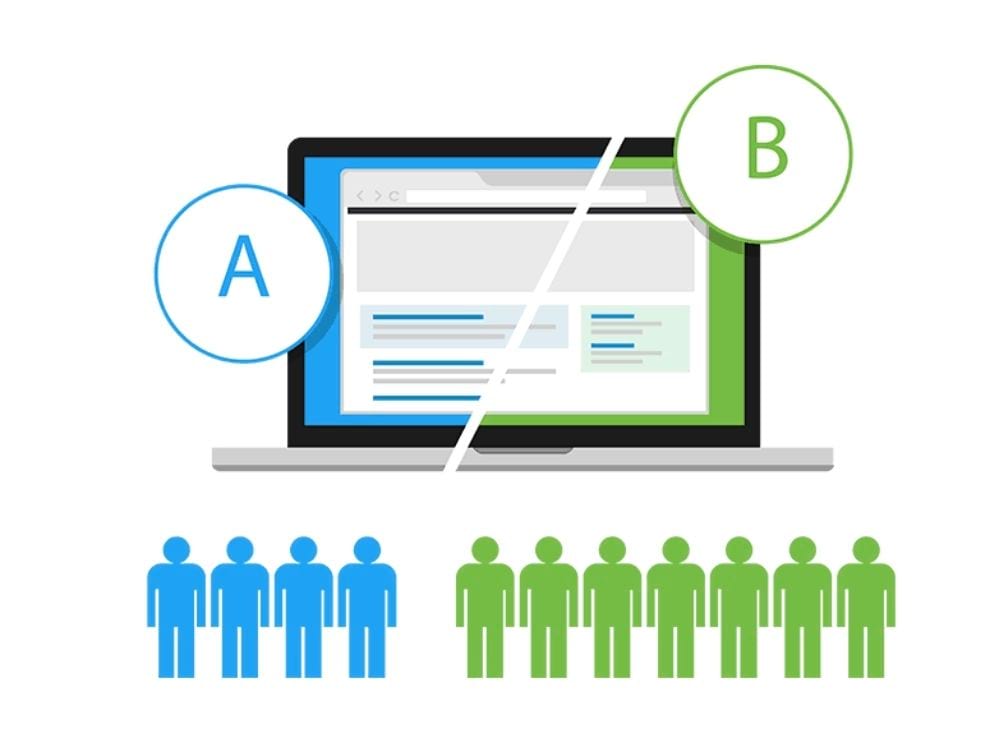
- Who is sending the email is important to the recipient. Most people won’t open an email if they don’t know it is from. Different email addresses can be used for each version.
- If testing the email content, areas that can be changed include CTAs (call to actions), headers or sub-headings, images or even the email design.
Once the versions have been decided, decide on the test group size; generally, 20-30% of the total subscriber list is a good benchmark. Ensure they are selected randomly and send both versions to the group. The version with the most open rates, higher click through rates and total unique clicks, or another performance metric of your choosing, will be the winner. Always ensure your subscriber list is as up-to-date as possible by validating email addresses.
Deciding what time/days to test your email
With A/B testing, or split tests, it’s important to monitor the test results to determine not only which version is the most popular, but also to understand which day and time slots are the best to send the email campaign to the remaining subscribers.
Measuring your test email’s success
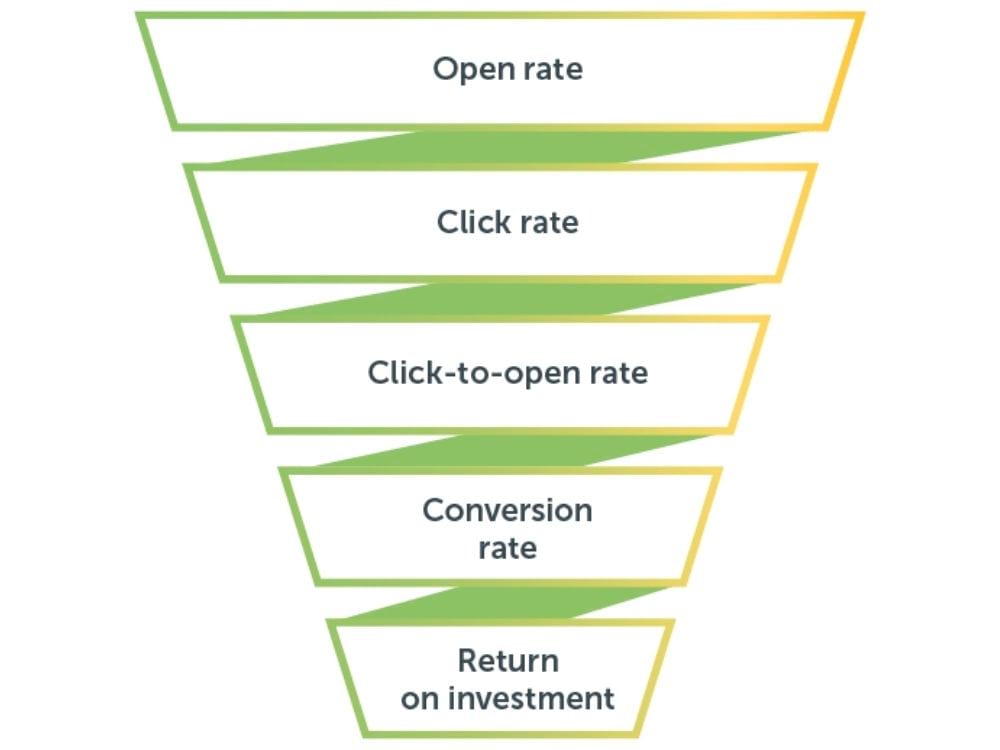
Measuring the effectiveness of your email campaign is crucial. According to Marketing Sherpa, the top KPIs for email marketing are open rate, click through rate and delivery rate. With 77% of consumers choosing email over other channels online, getting these three KPIs right is crucial.
- Open rate – this is the number of times your email has been opened by a recipient. The subject line is often the catch for subscribers to open the email and it should stand out.
- Click through rate – this is the number of times a recipient has acted upon the email, i.e. clicked on the link in the email.
- Delivery rate – this rate determines whether your email reached the right subscriber. If your campaign has a high delivery rate, it’s reached your intended recipients.
Still not getting your desired open rates?

How do I optimize my email campaigns?
- Focus on your subject line and make sure it stands out. Avoid spam or technical words. Keep it simple and to the point. Ensure it’s not too long; it’s got to be easily readable as the opening line.
- Keep the content conversational to connect with your audience. As Oscar Wilde said: “Don’t use big words, they mean so little.”
- Always include a strong call to action; add a time limit to the offer, if relevant.
- Personalize! Your audience wants to feel that they are a person, not just another email address.
- Target your relevant audience. Ensure your email campaign is sent to subscribers that are interested in your product/service.
- Use rich text in the content, i.e. bold, italics, underlining, larger and smaller fonts.
- Optimize for mobile devices. 81% of people use mobile devices and smartphones to check their emails.
How do I make my subject line stand out?
- Keep your subject lines clear and concise – stick to around 50 characters, particularly for mobile users.
- Focus on keywords – catch your audience’s attention and tell them what it’s about quickly.
- Use action-oriented verbs – they have the same effect as CTAs and visualize the action.
- Avoid capital letters and exclamation points – this is a tactic used by spam emailers. A study by the Radicati Group found that 85% of email recipients prefer a subject line in lowercase.
- A/B test your subject lines to determine the wording that works the best.
How do I make my message mobile-friendly?
- Keep your subject line to 50 characters – mobile devices, generally, show only 25-30 characters.
- Don’t forget pre-header text – it’s the first line of content in your email and backs-up your subject line.
- Keep the content clear and concise. Avoid long sentences and long paragraphs. Short, bite-sized chunks are easier for the reader to follow and understand.
- Sometimes an image is not always suitable – not all devices open images automatically.
- Ensure call to actions are prominent and towards the top of the email.
- Make the content click-friendly by ensuring there is sufficient white space around the link or click to action button.
- Test emails across different mobile devices.
Conclusion
If the current worldwide pandemic has taught businesses anything, it’s that email marketing is still as important as ever. Just about anyone that has internet access and an active email address – 56% of the global population has internet access – has connected with at least one new business a day.
As a business, if you haven’t ‘gone digital’ and started to harness the power of email marketing and digital marketing strategies, chances are you will be left behind by your competitors. The added bonus is that to create eye-catching, pleasing and effective email campaigns aren’t going to break the budget. That said, if businesses don’t know their target audience, don’t understand the best times to send an email campaign, or how to optimize and test their emails, the benefits just won’t transfer.
For small businesses, email marketing has become the go-to strategy over the past few years and enabled them to challenge the ‘big guys’ in their industry. Couple it with social media links and activity and companies have a winning combination.

